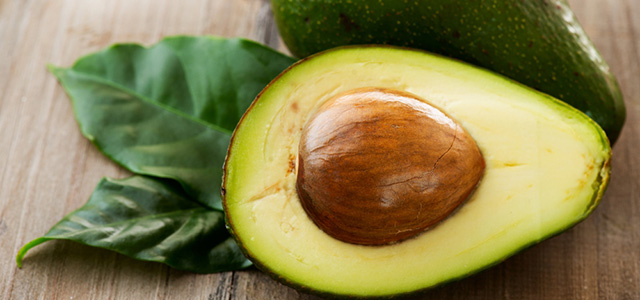The avocado is one staple in the Latin kitchen. Native to Mexico, Central America, and South America, the Spanish Conquistadors were the first Europeans to discover this versatile fruit, though historians suggest that avocados originated in the Mexican state of Puebla around 10,000 BC. While Latin cooks regularly use avocados in a variety of recipes as their star ingredient, avocados have gone mainstream—think Cobb salads, sushi rolls, sandwich toppings—and you can easily find avocado popping up as a popular component of healthy and inventive dishes throughout the world.
The word “avocado” comes from the Spanish aguacate, which refers to the pear-shape of the fruit. Like with most fruits, there are various types of avocados with the most well known and widely sold avocado being the Hass avocado. Available year-round, the Hass avocado is small in size, has a purple-black bumpy skin, a small pit and creamy texture. Similar to Hass avocados, Gwen avocados have the same pebbly skin, but grow larger, and have a stronger flavor. Their skin is thicker than other varieties, and they are only available through fall and early winter. The Fuerte avocado — considered the original California avocado — is the second most popular avocado in the United States, and more widely used along the west coast. True to its name, the Fuerte has a strong flavor, and a bright green skin with a smooth texture, but is quite difficult to peel because of its thin skin. Less common varieties include Bacon, Pinkerton, Reed, and Zutano.
Packed with mono and polyunsaturated fat content, avocados can be used as a substitute for ingredients like butter or shortening, which are rich in saturated fat. According to Dr. Jonny Bowden, author of The 150 Healthiest Foods on Earth, monounsaturated and polyunsaturated fats lower bad cholesterol and decrease the risk of heart disease. Avocados also contain oleic acid, an omega-3 fat found in other healthy foods like olive oil and nuts. High in fiber, avocados have nearly 20 vitamins, minerals and beneficial plant compounds. Replacing saturated animal fat with a healthy fat like avocado goes a long way in maintaining a healthy diet. When eaten in moderation, avocados can provide healthy fats for a balanced diet and contribute to long-term cardiovascular health.
Avocado can only be picked when they reach full maturity. They soften and ripen after they have been plucked from the treetops. If you want to store an avocado over a long period of time you can place them in your fridge to keep them from maturing and softening. To ripen an avocado, place it in a brown paper bag with a ripe banana and keep it on the kitchen counter for a few days.
Used to make both savory dishes like guacamole and sweet dishes such as paletas (popsicles) and ice cream, avocados have fast become a versatile ingredients in all kitchens around the world. Looking for some unique and interesting recipes featuring avocados? We’ve gathered some of our favorite avocado recipes together for you. Click here to check out our Five Ways With…Avocado feature from Muy Bueno Cookbook, or our Guacamole, Two Ways feature by Mexican chef Roberto Santibañez.


![Making Mealtime Matter with La Familia: Easy Sofrito [Video]](https://thelatinkitchen.com/wp-content/uploads/2015/10/sofrito-shutterstock__0-500x383.jpg)
![Easy Latin Smoothies: Goji Berry Smoothie [Video]](https://thelatinkitchen.com/wp-content/uploads/2015/12/goji_berry-shutterstock_-500x383.jpg)
















![Fun and Fast Recipes: Fiesta Cabbage Salad [Video]](https://thelatinkitchen.com/wp-content/uploads/2015/11/fiesta_cabbage_slaw-shutterstock_-500x383.jpg)









